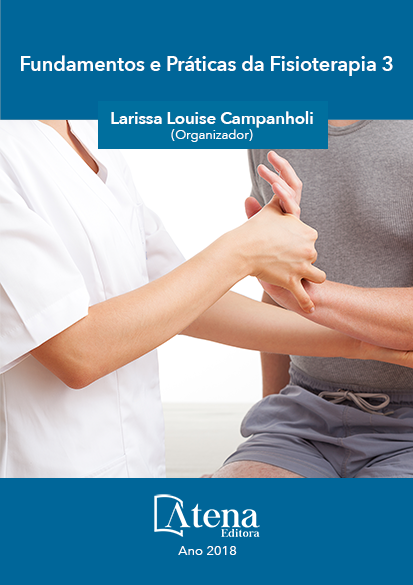
ANÁLISE DA ATIVAÇÃO MUSCULAR NA ATIVIDADE SENTADO PARA DE PÉ EM INDIVÍDUOS COM DOENÇA DE PARKINSON UTILIZANDO ELETROMIOGRAFIA DE SUPERFÍCIE
Objetivou-se analisar atividade
eletromiográfica durante atividade funcional
associada a avaliação clínica de indivíduos
com DP. Materiais e métodos: Estudo de
caráter transversal, comparativo com medidas
repetidas. 9 pacientes com DP divididos
em G1 leve (HY=1-3) e G2 grave (HY=4).
Realizaram três vezes a atividade sentado
para de pé, por meio da eletromiografia (New
Miotool wireless/Miotec) dos músculos reto
femoral (RF), tibial anterior (TA), sóleo (SOL)
e multífidos (MLT), determinou-se a atividade
muscular no momento Pico por meio da RMS
(root mean square) mensurada em uV. Perfil
clínico com antropometria, MEEM, HY, UPDRS
e PDQ-39. Estatística descritiva, testes de
normalidade de Shapiro-Wilk e Mann-Whitney
para comparação entre os grupos. Resultados:
5 indivíduos no G1 (3 homens) e 4 indivíduos
no G2 (1 homem). Ativação muscular no
G1 e G2 no RF (42,8±13,76; 48,49±13,82
p=0,36), TA (43,48±12,57; 44,3±20,11 p=0,76),
SOL (58,95±10,94; 66,31±11,53 p=0,26),
MLT (54,22±9,29; 62,8±8,35 p=0,02*). Perfil
clínico: idade (63±8,0; 61±10,5 p=0,38), IMC
(24,5±3,2; 22,3±5,1 p=0,22), tempo da doença
(7,6±6,8; 11±5,6 p=0,22), MEEM (27,8±1,6;
22,3±2,8 p=0,00*) HY (2,2±1,1; 4 p=0,01*),
UPDRS (15,8±9,8; 35,3±6,1 p=0,01*), PDQ-39
(32,7±12,2; 47,9±7,7 p=0,03*). Conclusão: Na
atividade funcional, a ativação muscular Pico
dos multífidos foram significativamente mais
recrutados pelo grupo grave em comparação
com o grupo leve. Pacientes estadeados na
escala HY no estágio IV apresentam maior
comprometimento cognitivo e déficits motores
que interferem na sua qualidade de vida
(QV). Intervenções terapêuticas podem ser
implementadas para prevenção de quedas e
melhoria dos aspectos relacionados a QV.
ANÁLISE DA ATIVAÇÃO MUSCULAR NA ATIVIDADE SENTADO PARA DE PÉ EM INDIVÍDUOS COM DOENÇA DE PARKINSON UTILIZANDO ELETROMIOGRAFIA DE SUPERFÍCIE
-
DOI: atena
-
Palavras-chave: eletromiografia de superfície, quedas, doença de Parkinson.
-
Keywords: surface electromyography, falls, Parkinson’s disease.
-
Abstract:
to analyze electromyographic
activity during functional activity associated with
clinical profile of individuals with PD. Materials
and methods: Cross-sectional, comparative
study with repeated measurements. 9 patients
with PD divided in mild G1 (HY = 1-3) and severe
G2 (HY = 4). Three times the standing up activity, through electromyography (New
Miotool wireless / Miotec) of the femoral rectus (FR), anterior tibial (AT), sole (SOL) and
multifidus (MLT) muscles, was determined muscle at the Peak moment by means of
RMS (root mean square) measured in uV. Clinical profile with anthropometry, MEEM,
HY, UPDRS and PDQ-39. Descriptive statistics, normality tests of Shapiro-Wilk and
Mann-Whitney for comparison between groups. Results: 5 individuals in G1 (3 men)
and 4 individuals in G2 (1 men). Muscle activation in G1 and G2 in FR (42.8±13.76;
48.49±13.82 p=0.36), AT (43.48±12.57, 44.3± 20.11 p=0.76), SOL (58,95±10.94;
66.31±11.53 p=0.26), MLT (54.22±9.29; 62.8±8.35 p=0.02*). Clinical profile: age
(63±8.0, 61±10.5 p=0.38), BMI (24.5± 3.2; 22.3± 5.1 p=0.22), disease time (7.6±6.8;
11±5.6 p=0,22), MEEM (27.8±1.6; 22.3±2.8 p=0.00*) HY (2.2±1,1 p=0,01*), UPDRS
(15.8± 9.8; 35.3± 6.1 p=0.01*), PDQ-39 (32.7±12.2; 47.9±7.7 p=0.03*). Conclusion:
In the functional activity, the muscle activation Peak of the multifidus was significantly
more recruited by the severe group in comparison with the light group. Patients on the
HY stage IV have greater cognitive impairment and motor deficits that interfere with
their quality of life (LQ). therapeutic interventions can be implemented to prevent falls
and improve aspects related to LQ.
-
Número de páginas: 15
- Heloyse Uliam Kuriki
- Poliana Penasso Bezerra
- Tatyana Nery


